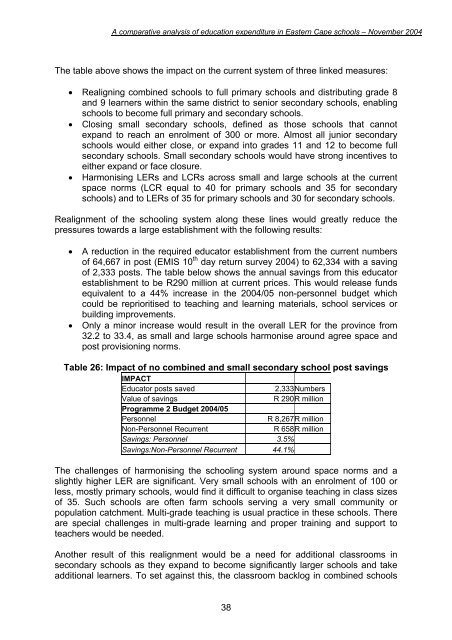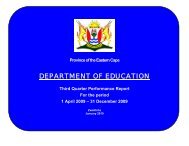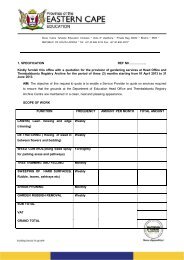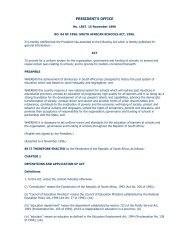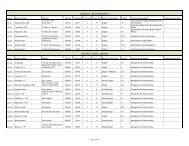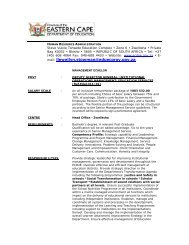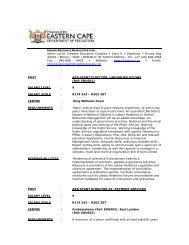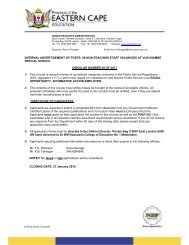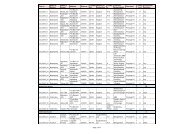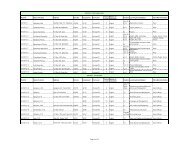School Community Integration Pilot Project - Department of Education
School Community Integration Pilot Project - Department of Education
School Community Integration Pilot Project - Department of Education
Create successful ePaper yourself
Turn your PDF publications into a flip-book with our unique Google optimized e-Paper software.
A comparative analysis <strong>of</strong> education expenditure in Eastern Cape schools – November 2004<br />
The table above shows the impact on the current system <strong>of</strong> three linked measures:<br />
• Realigning combined schools to full primary schools and distributing grade 8<br />
and 9 learners within the same district to senior secondary schools, enabling<br />
schools to become full primary and secondary schools.<br />
• Closing small secondary schools, defined as those schools that cannot<br />
expand to reach an enrolment <strong>of</strong> 300 or more. Almost all junior secondary<br />
schools would either close, or expand into grades 11 and 12 to become full<br />
secondary schools. Small secondary schools would have strong incentives to<br />
either expand or face closure.<br />
• Harmonising LERs and LCRs across small and large schools at the current<br />
space norms (LCR equal to 40 for primary schools and 35 for secondary<br />
schools) and to LERs <strong>of</strong> 35 for primary schools and 30 for secondary schools.<br />
Realignment <strong>of</strong> the schooling system along these lines would greatly reduce the<br />
pressures towards a large establishment with the following results:<br />
• A reduction in the required educator establishment from the current numbers<br />
<strong>of</strong> 64,667 in post (EMIS 10 th day return survey 2004) to 62,334 with a saving<br />
<strong>of</strong> 2,333 posts. The table below shows the annual savings from this educator<br />
establishment to be R290 million at current prices. This would release funds<br />
equivalent to a 44% increase in the 2004/05 non-personnel budget which<br />
could be reprioritised to teaching and learning materials, school services or<br />
building improvements.<br />
• Only a minor increase would result in the overall LER for the province from<br />
32.2 to 33.4, as small and large schools harmonise around agree space and<br />
post provisioning norms.<br />
Table 26: Impact <strong>of</strong> no combined and small secondary school post savings<br />
IMPACT<br />
Educator posts saved<br />
2,333Numbers<br />
Value <strong>of</strong> savings<br />
R 290R million<br />
Programme 2 Budget 2004/05<br />
Personnel<br />
R 8,267R million<br />
Non-Personnel Recurrent<br />
R 658R million<br />
Savings: Personnel 3.5%<br />
Savings:Non-Personnel Recurrent 44.1%<br />
The challenges <strong>of</strong> harmonising the schooling system around space norms and a<br />
slightly higher LER are significant. Very small schools with an enrolment <strong>of</strong> 100 or<br />
less, mostly primary schools, would find it difficult to organise teaching in class sizes<br />
<strong>of</strong> 35. Such schools are <strong>of</strong>ten farm schools serving a very small community or<br />
population catchment. Multi-grade teaching is usual practice in these schools. There<br />
are special challenges in multi-grade learning and proper training and support to<br />
teachers would be needed.<br />
Another result <strong>of</strong> this realignment would be a need for additional classrooms in<br />
secondary schools as they expand to become significantly larger schools and take<br />
additional learners. To set against this, the classroom backlog in combined schools<br />
38


